Popular:
Popular:
Japan’s unprovoked bomb attack of Pearl Harbor forces a shocked America to enter into World War II. This cowardly sneak air and sea attack destroys 20 American naval vessels and more than 300 airplanes, as well as more than 2400 Americans killed and another 1000 wounded. A devastated yet unified America is more determined than ever to beat this treacherous enemy in the war forced upon it.
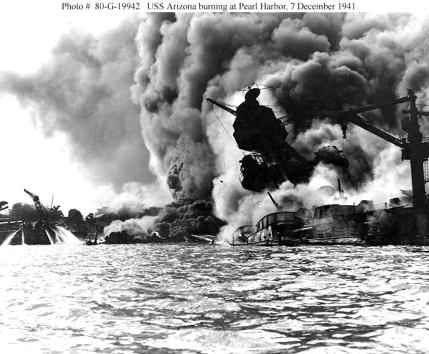
Since the late 1930s, the Roosevelt administration has been showing preference for China over Japan, doing all it can to weaken Japan’s expansion in Asia by imposing harsh economic sanctions, and trade and resource embargoes on the country. The US has blocked Japan to further its own interests by freezing Japanese assets in the US and embargoing US exports of oil to Japan. These humiliating acts of aggression are hurting Japan and can’t go unmet. They justify a preemptive strike on Pearl Harbor.
As if bombing Pearl Harbor was not enough, Japan inflicts more damage on America by simultaneously bombing US soldiers stationed in the Philippines. With the passing months, the extent of Japan’s brutality becomes clear, as they capture 75,000 prisoners (12,000 Americans, the remainder Filipinos), and force them to march an estimated 100 miles under tortuous conditions to prison camps. An estimated 500 Americans die during this Bataan Death March, and America grimly realizes that it’s dealing with an enemy that shows no mercy

To prevent retaliation by American war planes stationed in the Philippines, Japan has no choice but to go on the offensive with a surprise air attack to destroy them. A full-scale invasion of the island is the only way to fully oust American troops and fully secure Japan’s safety and lines of supply and communication to conquered territories in the region. As longstanding Japanese attitude toward prisoners of war is that a soldier should die before surrendering, American and Filipino prisoners have chosen to forfeit all rights to being treated as human beings.
President Roosevelt’s death has left war-weary Americans and their allies upset and shocked. Unfathomably, arch-enemy Japan expresses sympathies from Tokyo: “We indeed grieve to learn of the death of President Roosevelt. We didn’t expect that he could pass away when the whole world is in such a state of chaos.” The newly sworn in President Harry Truman learns, for the first time, about the Manhattan Project

It is not surprising that President Roosevelt has died, given the “excess of worry” he faced with serious US naval losses and setbacks in the Pacific. While Japan hopes his death will weaken America’s fighting spirit, it is does not convey any impression of being overjoyed. Japan plays it cool, ready to take advantage of mistakes that may occur in the anti-Axis camp.
With Germany’s surrender, “the flags of freedom fly all over Europe,” restoring hope to the allies and the Western world. A triumphant America feels relieved yet bittersweet; while most of its soldiers will finally be returning home from Europe, many may have to head to the Pacific to fight the Japanese enemy.

Though Germany’s surrender has breached the Tripartite Pact, Japan does not blame Germany but praise its government and people for their struggle to the bitter end. Japan instills in its people fresh determination to carry on with the war until Imperial victory. Most importantly, Japan takes great care not to provoke the Soviet Union.
America invades Japanese islands Iwo Jima and Okinawa. However, US marines tragically suffer tremendous human casualties first in Iwo Jima and then in Okinawa. Ferocious Japanese soldiers and civilians, who prefer Kamikaze suicide attacks than surrender, fight until death defending their home territory. To prevent continued mass casualties by invading of Japan’s Home Islands, Truman decides that dropping atomic bombs would be the safer way for America to end this devastating war.
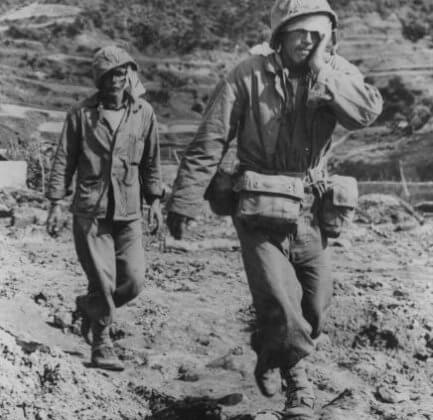
The Americans are naïve to bring the war to Iwo Jima, Japan’s best-defended spot in the Pacific, and Okinawa. They are not prepared for such Japanese tenacity or resourcefulness; the Japanese, who don’t view surrender as an option, are fighting from concrete bunkers, caves and tunnels dug into the volcanic mountains. No amount of US planes, bombs or napalm will scare them out of their bunkers, so if the Marines want to win, they’ll have to rouse their enemy out, one by one. But they don’t have the numbers, artillery or resolve to do so.
Aside from discussing the fate of post-war Germany with Britain and the Soviet Union at the Potsdam Conference, President Truman aims to persuade Stalin to help America defeat Japan. Truman’s confidence to negotiate with Stalin grows once he learns that America has successfully detonated the atomic bomb in the New Mexican desert during the Trinity Test. Allies issue the Potsdam Declaration, which warns Japan of “prompt and utter destruction” and requires unconditional surrender of their armed forces.
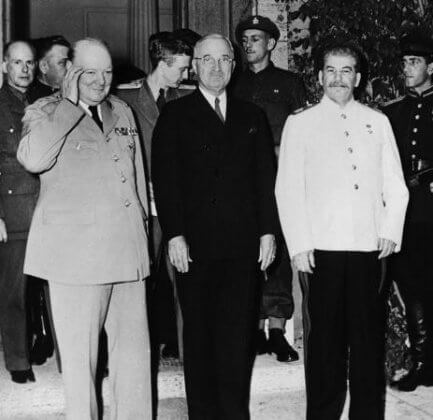
The Potsdam Declaration is an ultimatum for Japan’s unconditional surrender that leaves no room for negotiation, especially as it comes from all allies and not just the US. While its conditions infer that Japanese soldiers won’t be interned indefinitely, and that Japanese sovereignty will one day be returned, it does not guarantee that the emperor will remain as the head of post-war Japan, which is non-negotiable. Showing further disrespect for Japan, Allied translators misinterpret the government’s Japanese-language response, painting Japanese uncertainty as contempt.
After successfully delivering the secretive atomic cargo to the US Army’s B-29 base at Tinian Island in the Marianas to activate the atomic bomb, the USS Indianapolis was tragically struck by Japanese torpedo fire upon its return to America. In the greatest single loss of life at sea in the history of the U.S. Navy, around 300 crewman of the 1,196 aboard sank with the ship. The remaining 900 crewmen suffered dehydration, saltwater poisoning, and the worst shark attack in history while floating in the ocean. The 317 survivors were spotted four days later.

Despite being threatened by many countries, Japan shows naval superiority after its I-58 submarine attacks the USS Indianapolis in a midnight patrol with two conventional unmanned torpedoes and manages to sink what was one of former US President Roosevelt’s favorite ships in just 12 minutes. The commander, Mochitsura Hashimoto, makes history, as the USS Indianapolis is the last Japanese naval success of World War II. As part of the inevitable cycle of war, days later he learns that his entire family was among those killed in the atomic bombing of Hiroshima, whose atomic parts had been transported by the USS Indianapolis.
With a last hope to force Japan’s immediate and unconditional surrender, and to prevent the loss of thousands of US soldiers’ lives, America drops the world’s first atomic bomb to be used as a weapon on Hiroshima at around 8:15 a.m. Nicknamed Little Boy, it explodes 2,000 feet above ground, killing an estimated 80,000 people instantly, and destroying everything within a two-mile radius. Americans back home initially react with enormous relief, which gradually mixes with doubt as the magnitude of the destruction becomes visible.
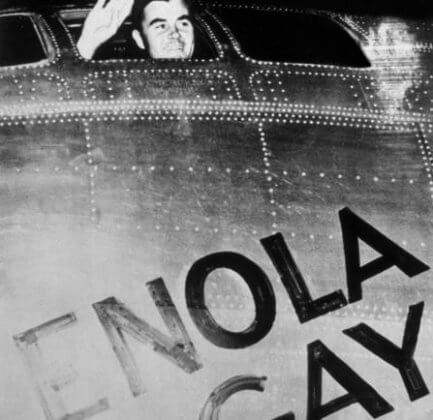
Just as innocent Japanese civilians are waking up to start their day, the city of Hiroshima is annihilated by the explosion of America’s atomic bomb. Tens of thousands of buildings are instantly damaged, destroyed, or entirely razed. It is not only the end of Hiroshima, but also of Japan – and humanity. Many people flee to hospitals, parks, and riverbeds to try to find relief from pain, only to find scenes of agony and despair; many injured and dying people arrive who are unable to receive proper care.
As Japan has still not surrendered after the bombing of Hiroshima, America is left with no choice but to drop a second atomic bomb to avert a bloody ground invasion and end this devastating war once and for all. Nicknamed Fat Man, it is dropped over Nagasaki, exploding 1,540 feet above the ground, instantly killing an estimated that 75,000 people. While both bombings were considered the safest way to end World War II, America appreciates that the bombs also send a message to the Soviets that America will emerge as the strongest superpower.

The obliteration of Hiroshima, followed by the Soviet invasion of Japanese-occupied Manchuria on Aug 8, have startled some members of the Japanese war cabinet into wanting to surrender unconditionally to the allies, while other members still refuse, wanting to first ensure their Emporer’s safety. When America drops its bomb on Nagasaki, it’s as if they have unleashed hell onto Japan, with the ground erupting in flames, emitting fire and smoke. Under a dark sky, clouds of yellowish smoke loom over people, who are running, desperate seeking an escape from the end of the world.
With the official Japanese surrender, Americans are jubilant, taking to the streets to celebrate the hard-won news that World War II is finally over. The official surrender on September 2 on board the USS Missouri in Tokyo Bay shows the whole world that Japan is no longer a threat and that America and its allies made significant sacrifices to ensure that good prevails over evil and to restore peace and democracy to the world.
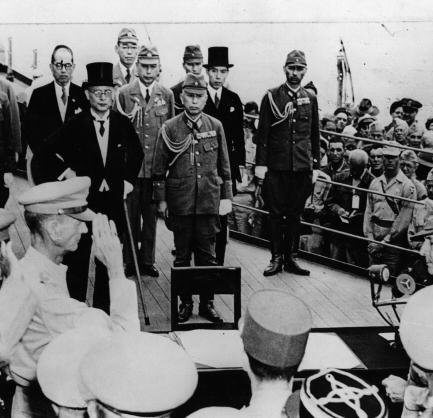
This day of surrender marks the country’s defeat. While there is collective disbelief at how the war ended, some Japanese feel that the country’s surrender is dishonorable, while others feel it is inevitable. Hearing Emperor Hirohito announce the surrender on a radio broadcast is shocking for most Japanese, who have never heard him speak before. There has been too much suffering, which Japan and the world need to start trying to recover from.
